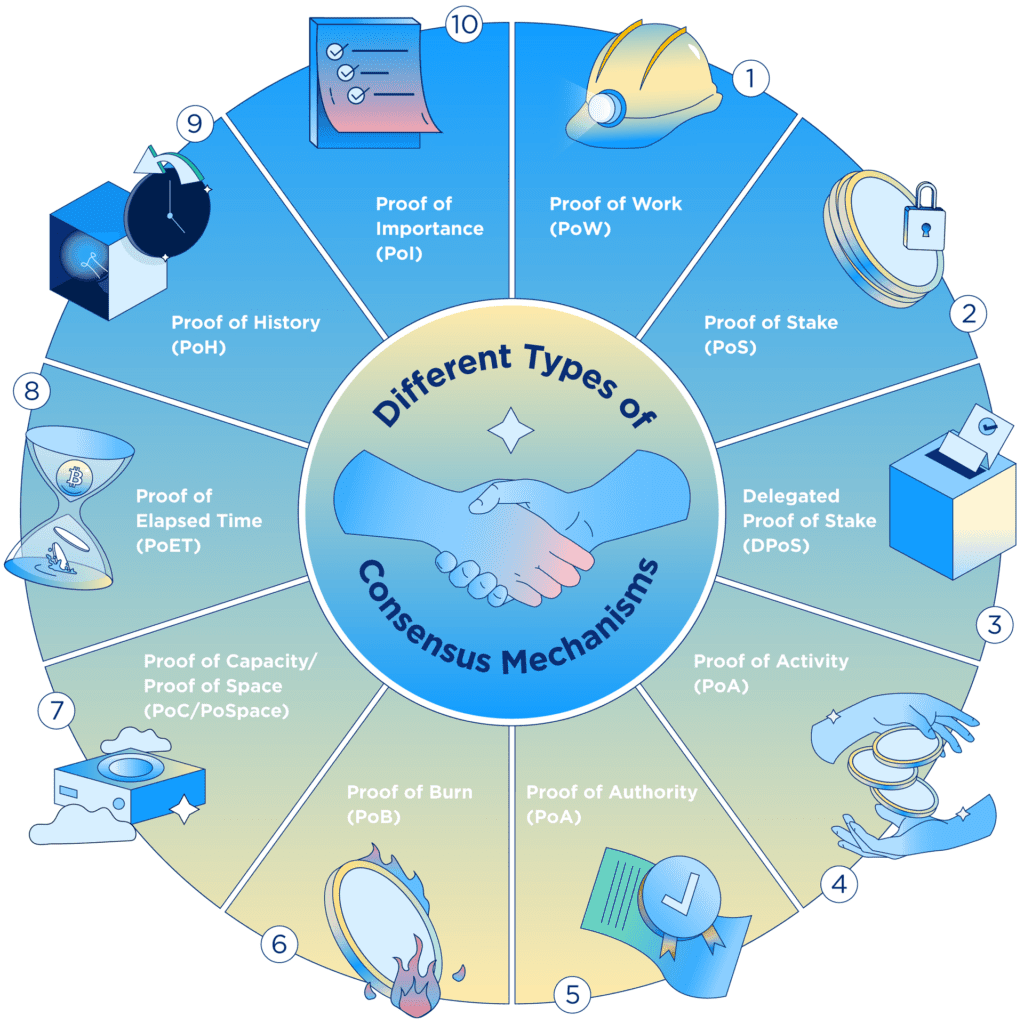With the upcoming ethereum “Merge” now scheduled for next month, the hotly debated Proof of Work (PoW) versus Proof of Stake (PoS) has been brought into the center stage of crypto news.
The long-awaited shift has been delayed several times, with the two camps of the crypto community coming head to head on its potential dangers and benefits to the world’s second-biggest blockchain. Some pro-PoWs even threaten the development of spin-off chains to maintain the current infrastructure.
There are over 1,000 blockchains with over 12,000 active cryptocurrencies. Most blockchains use either PoW or PoS, although there are additional mechanisms. However, for those new and inexperienced to the Web3 space, the difference between the two (and, as a result, the news of the ethereum shift) can be vastly confusing.

What are they?
Fundamentally PoW and PoS are consensus mechanisms. They are used within the blockchain to achieve the necessary agreement on a data value or single network state among the distributed nodes. This, in turn, creates trust and security across the decentralized network.
PoW relies on miners
PoW is the longest-standing mechanism within Web3 and has been used by bitcoin and, until now, ethereum, among others.
“The PoW mechanism makes the ethereum chain secure and less vulnerable to economic attacks. It is a method to verify the creation of new transactions on the ethereum blockchain to keep the blockchain secure,” said Bilal Bin Saqib, Blockchain Marketing Advisor, and Consultant.

The system relies on competing “miners,” explained Juan Valcarcel, Crypto Developer. “Users with dedicated hardware that calculate complex hashing to find the solution to a math problem are rewarded by a new emission of the coin being mined.”
For many, it is the tried and tested route for consensus, bringing a level of security and reliability superior to other mechanisms. It is also seen as the simplest to implement.
Despite this, the computational power needed for miners to conduct their work is extremely high, posing barriers to entry in terms of cost and high energy needs, which has caused criticism in terms of carbon emissions.
PoS relies on staking
The PoS mechanism, as the name suggests, uses “staking,” where individuals denote a certain amount of their cryptocurrency and then are randomly chosen as validators. The more staked, the more they receive, and there is a higher probability of being selected to validate. Prominent users of the PoS system are Cardano and Solana.
The incentive to stake is directly related to the efficiency of the network. With more people staking, the more efficient the network becomes. There are also associated processes that deter negative behavior in the network.

“There is a process on PoS known as slashing, which deters behavior that would negatively impact the network, like validator downtime or double signing,” said Yves Longchamp, Head of Research at SEBA Bank.
PoS is seen as a more environmentally friendly consensus system that could have higher security against a 51% attack. This is where there is a coordinated attack from miners or validators who control over 50% of a cryptocurrency and use it to alter the blockchain consensus.
“PoS allows you to be more precise when punishing bad actors, creating a stronger security model,” said JakeAndStake, Bankless DAO contributor. “You don’t have to continuously pump electricity into the hashing algorithm to keep it secure, so there’s also a reduction in energy consumption.”
“In addition, there’s an increase in decentralization where, because the hardware costs are lower, anyone can run a validator, and more people can run it up profitably. And then there’s settlement finality, which allows you to prune the database. That was one of my biggest concerns with bitcoin, especially in 2017.”
“At a certain point, you need a tonne of memory to store all the transactions because the blockchain is continuously growing. This puts a limitation on who can run a node. One day the network is at a certain point where only certain people or entities can afford that kind of memory and be able to run a node (creating more centralization). I think that adds to the longevity and sustainability of PoS.”
The battle of decentralization
“Staking allows the chain to be more decentralized. Through the Proof-of-Stake mechanism, control of the network will be transferred to the tokens’ owners,” continues Bin Saqib.
There is a slight difference in opinion on whether this is the case. Many believe decentralization to be more prevalent in PoS as it spans a broader group of individuals who would have more challenges coordinating themselves into 51% attack.
However, in introducing new cryptocurrencies under this mechanism, there is an element of early adopter power, where the control could pertain to only one or very few of the currency holders who had made the primary investments.
In the case of ethereum, this is unlikely as the ownership pool has been established and diluted to the point where coordination would have to span thousands of individuals to reach over 50%.
Staking also allows a level of decentralization in terms of the ease of access to rewards. For PoW miners, the start-up and running costs are high. For PoS, any owner of the currency can stake and receive remuneration.
Why should you care?
On the surface, the impact on the average consumer is minimal. Both mechanisms ensure a level of security and reliability of the blockchains they pertain to and are implemented to maintain the efficient running of the network.
However, as explored above, there are significant differences in the make-up of the two mechanisms.

The ecological issue of PoW
The most prevalent difference is the ecological impact. The difference is so significant that the European Central Bank (ECB) launched an investigation earlier this year and has since hinted at a ban on PoW-based blockchains.
The ECB found that the estimated electricity consumption of bitcoin, the world’s largest PoW blockchain, is in line with the energy consumption of countries such as Spain or Austria. Estimates of the carbon footprint of bitcoin and ethereum under the PoW mechanism from the past year negate the emissions savings for most euro area countries.
“Staggeringly, the average user on the bitcoin network consumes approximately 121.86 TWh per year and 52.27 TWh per year on ethereum,” said Chad Barraford, Technical Lead at THORchain. “An entire Cosmos-based (PoS) blockchain consumes less energy in a year than a PoW blockchain like bitcoin in one day.”

Estimates from the ethereum foundation have found the shift from PoW to PoS would reduce the energy consumption by 99.95%, bringing it on par with a small town.
High emissions by design or due to infrastructure?
Despite this, there is some difference of opinion as to the culpability of this issue.
“Bitcoin is just a code,” said Valcarcel. “It’s not to blame because we humans cannot generate clean energy or miners don’t use it. It could actually incentivize using green energy, as Bitcoins can be created anywhere in the world.”
“When you think of storing, moving, and creating electricity infrastructure, that’s a costly and complex problem. With PoWs, that does not exist as you can have a miner in the middle of the Sahara powered by solar with a satellite connection. You are creating value without having to move it anywhere.”
This point concerns whether the mechanism is to blame or whether it is a question of switching the energy source. Currently, the use of renewable energy to power PoW remains voluntary.
In the ECB report, the use of renewable energy is examined. However, the bank remains skeptical. They state there may be an issue of overcrowding of the renewable energy sector, which currently only makes up 29% of the global energy creation. They also claimed concern that using the energy to power mining may take away from the renewable energy available to power houses, while resources were still limited.
“The fact of the matter is that we’re not there yet,” said JakeAndStake. “There isn’t a situation where bitcoin mining is powered 100% by sustainable energy. If it did happen, all that hashing power would be in the areas of renewable energy. So that also creates a bit of a centralizing effect.”
“Additionally, as the value of a POW system’s block reward increases, more economic resources (electricity) will be used to capture it; this can lead to an ever-increasing demand for the diversion of energy to the POW system.”
Bitcoin’s answer to the emissions reduction of ethereum’s merge
Despite this debate, the bitcoin community is far from silent and has moved to create its response to reduce carbon emissions.
The Crypto Climate Accord and the Bitcoin Mining Council are two of the most notable initiatives. The first focuses on the decarbonization of the blockchain industry, with more than 200 supporters committing to net zero emissions. The Bitcoin Mining Council (BMC) is a voluntary forum formed to “Promote transparency, share best practices, and educate the public on the benefits of bitcoin and bitcoin mining.”
In a recent report conducted by the BMC, collecting data from over 50% of the global bitcoin network, they found that the bitcoin mining electricity mix had increased to an estimated 59.5% sustainable in Q2 2022. Additionally, year-on-year, they estimated the global bitcoin network’s technological efficiency grew by 46%.
However, some in the crypto community have challenged the BMC’s data, arguing that the methodology is not explained and criticizing the lack of details.

Security focus of network changes
Although both consensus mechanisms provide a certain level of security, where the security is focused changes.
The PoW system has its security based on the history of its usage. Two of the most prominent blockchains have used the consensus mechanism in their rise to success. It has stood the test of time, and new blockchains are built using the mechanism.
However, in the case of PoS, the security it offers comes into play significantly in the prospect of a 51% attack or any malicious behavior.
“Suppose you found a set of block producers in POW acting maliciously, and they have most of the hash power. The only way to stop them is to change the hashing hardware,” said JakeAndStake. “In doing that, you make this huge change where everyone has to move over to this new hardware simultaneously. This will certainly punish the bad guys, but you’re also the good guys because everyone has to switch.”
“In proof of stake, if you find someone misbehaving, you can kick them out and do it surgically. You can say, ‘These are bad people, so let’s destroy their stake and remove them from the validator set.’ The good guys aren’t harmed because they’re still chugging along, doing their validating thing. But now, if the bad actors want to perform another attack like that, they will have to acquire more assets again.”
“The incentive model to behave well is a lot stronger in proof of stake, at least ethereum’s design.”
Merge as a key to unlocking blockchain potential
According to sources, whether a consensus mechanism is PoW or PoS is unlikely to cause any significant changes that consumers will notice.
Changes that may be noticeable in the upcoming ethereum merge, providing everything goes to plan, include decreases in gas fees and increases in transaction efficiency. Some also believe there may be a rise in value.
“Once the final phase of the upgrade is completed, consumers will be able to make thousands of transactions per second,” said Bin Saqib. “An amazing jump from the 7-15 transactions per second that the chain can handle now.”
“I believe the merge will open doors the countless opportunities and will onboard a significant number of users to Web3 and blockchain. I see the merge as a bridge that will make the ethereum blockchain accessible, efficient, and scalable. We will see the true potential of blockchain and its impact on our lives.”


